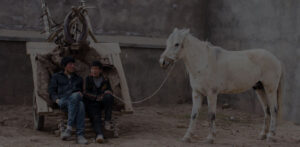Early human communities hunted and gathered food together, and they tended to share their produce. The only personal property would be something that one had made for himself, like a bow or a flint knife. The transition to a settled agrarian economy resulted in the separation of labor. People started to produce much more of one thing than they needed, and they had to rely on others to produce the other items that they needed. They had to trade.
In simplest terms, let’s say I am a grain farmer, and you raise chickens (not that one can’t do both). If I want a chicken and you want some grain, and we can agree on how much of my grain one of your chickens is worth, then we would be in business. If only it were so simple. Fortunately the chicken is alive, and I can feed him with grain, so if you want some of my grain now, and I know I will want a chicken next week, then I might be willing to make the swap now. And, since dried grain doesn’t spoil quickly, you might be willing to make the swap before you need the grain if I want the chicken now. But, if I am a dairy farmer, it becomes difficult to make this work, since my product spoils.
So, let’s explore that for a moment. Let’s say that I still produce grain. You have chickens. Our friend Karl has dairy cows. Karl wants a chicken today, but you don’t need milk right now, and if you take it early, it will spoil. But you need grain, and I need milk today. If all three of us can agree on a fair exchange, then we can do a three-way barter. In fact, because my grain has a long shelf life, we can effectively use it as money. I buy milk from Karl with my grain, and now Karl has grain which you need and will trade him for the chicken he wants. If he has a bit too much grain left over, that’s okay. He can save it for later or for trading again. In ancient Egypt, wheat and barley were the currency, and a highly complex economy developed in the Egyptian Empire before the invention of coin.
But what if you want something that I have that is worth many chickens (like my teenage daughter)? You don’t want my grain, and Karl is no help because his milk spoils. If we can agree on a price, like 50 chickens, we still have a problem. I don’t want 50 chickens right now, because I don’t want to feed them. You also don’t have that many to give me without crippling your chicken raising business. So instead, maybe we agree that you will give me one chicken every Friday for a year. Writing was invented to keep track of transactions like these.
Once we start using a commodity with a long shelf life as a form of currency, it is not too great a leap to switch to a good with unlimited shelf life, specifically metals. The most commonly used metal for coins in the ancient world was bronze. This makes sense as the invention of coins occurred during the latter part of the bronze age, so the actual metal was the most useful. Oddly though, the first inventors of coins did not use bronze.
Sometime between 700 BC and 600 BC in a kingdom called Lydia in Anatolia (modern Turkey), a naturally occurring alloy of gold and silver was discovered. They called it Electrum, and they made coins out of it. We don’t know what the exchange rate of these coins was, and we can’t estimate their intrinsic value, because we don’t know what value the Lydians placed on gold or silver. You can’t make a sword or axe or even a plow head out of them. We do know, based on the number found, that they were cast and traded. The Lydians had solved the problem of how to store wealth.
Next time: the Lydian invention spreads like wildfire through the Greek world.
